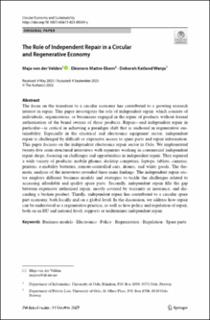| dc.description.abstract | The focus on the transition to a circular economy has contributed to a growing research interest in repair. This paper investigates the role of independent repair, which consists of individuals, organisations, or businesses engaged in the repair of products without formal authorisation of the brand owners of these products. Repair—and independent repair in particular—is critical in achieving a paradigm shift that is anchored in regenerative sustainability. Especially in the electrical and electronics equipment sector, independent repair is challenged by difficult or expensive access to spare parts and repair information. This paper focuses on the independent electronics repair sector in Oslo. We implemented twenty-five semi-structured interviews with repairers working in commercial independent repair shops, focusing on challenges and opportunities in independent repair. They repaired a wide variety of products: mobile phones, desktop computers, laptops, tablets, cameras, printers, e-mobility batteries, remote-controlled cars, drones, and white goods. The thematic analysis of the interviews revealed three main findings. The independent repair sector employs different business models and strategies to tackle the challenges related to accessing affordable and quality spare parts. Secondly, independent repair fills the gap between expensive authorised repair, mostly covered by warranty or insurance, and discarding a broken product. Thirdly, independent repair has contributed to a circular spare part economy, both locally and on a global level. In the discussion, we address how repair can be understood as a regenerative practice, as well as how policy and regulation of repair, both on an EU and national level, supports or undermines independent repair. | en_US |

